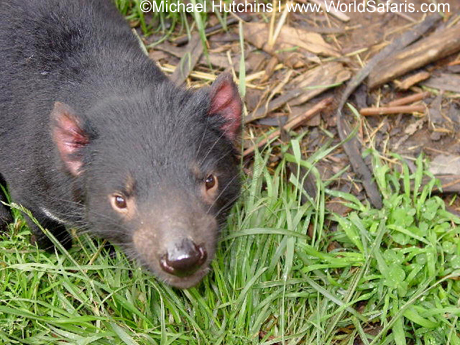A trip to Tasmania is like stepping into another world. The largest island off the southeastern coast of Australia is a temperate wonderland of nature. Giant tree ferns litter the wet, temperate forests and wildlife abounds. Among the island state’s most interesting mammals are the Tasmanian devil and spotted quoll or native cat. The devil (Sarcophilus harrisii) has been eliminated from the mainland, and now only exists on Tasmania. Extinction on the mainland is often blamed on the arrival of the dingo, as Tasmania is dingo-free. Indeed, the stocky, cantankerous Tasmanian devil is now the largest extant carnivorous marsupial (family Dasyuridae) following the extinction of the Thylacine or Tasmanian wolf. The Tasmanian devil has iconic status and is the symbol of this island state. It was also made famous by the Looney Tunes cartoon character, “Taz”, whose antics have delighted many a child around the world. But the real animal is nothing like the animated version.
Devils are polygynous and males compete to mate with as many mature reproductive females as possible. Like all marsupials, the young are born in an early stage of development (newborns weigh less than an ounce) after a three-week gestation and are reared in a pouch. As many as 20-30 young can be born, but there are only four nipples in the pouch and competition, even among the young, can be fierce. Many do not survive. Young devils grow very rapidly and are ejected from the pouch at around 100 days of age. The intense level of competition extends into adulthood and devils are well-known for their aggressive behavior at kills. Competing for meat, the animals bare their teeth and produce loud, hair-raising vocalizations. However, the animals live a fairly solitary life after weaning, only coming together to mate during the breeding season. The devils occupy home ranges, but are not territorial, although females will defend breeding dens. Like many so-called “solitary” animals they exist as part of a social network, where individuals know each other, primarily by scent.
Today the Tasmanian devil is considered endangered. The species is threatened by a transmissible type of cancer called the facial tumor disease, which may be passed from animal to animal during fighting. The relatively recent introduction of the non-native placental fox to Tasmania may also pose a threat.
Tasmanian devils are difficult, but not impossible, to see by wildlife tourists. However, they are primarily active at dawn and dusk, so observations must be done by spotlighting. It is also possible to see devils at the Tasmania Zoo, which is located in the Tamar Valley near Launceston. Let World Safaris help you plan a Tasmanian adventure.


Recent Comments